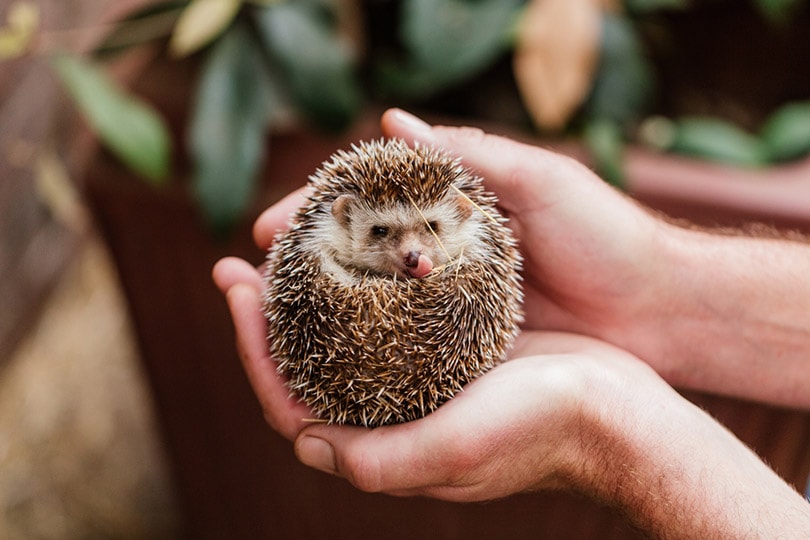VET APPROVED

The information is current and up-to-date in accordance with the latest veterinarian research.
Learn more »The African pygmy hedgehog (Atelerix albiventris) is one of the most common hedgehog species kept as exotic pets in North America. It can turn out to be a very charming and not at all prickly pet if it is well tamed. But is it really a good choice for allergy sufferers who have given up on cats and dogs? The short and sweet answer is that hedgehogs do not trigger most allergies in the majority of humans. But there’s a catch: even though these adorable little creatures aren’t known to cause allergies in most people, they can still carry diseases that may be harmful to their human caretakers.
Let’s see the details of this thorny question.
Can Hedgehogs Cause Allergic Reactions in Some People?
Unfortunately, yes. Although hedgehogs are generally considered good pets for people with allergies to cats, dogs, rabbits, and other furry companions, they can still cause allergic reactions in some people.
Indeed, a number of infections can be transmitted to humans from these tiny, quilled mammals, and they are possible hosts for parasites. Dermatological disorders can also be observed in handlers of hedgehogs.
What Allergic Reactions Can Hedgehogs Cause?

Contact and handling of hedgehogs can cause:1
- Dermatophytosis (cutaneous inflammatory reaction)
- Rash
- Urticaria
- Erythema
- Redness
- Itching
- Asthma
- Rhinitis
- Conjunctivitis
These allergic reactions can be caused by the hedgehog’s quills, saliva, fungi, mites, or other parasites present on the animal:
- Hedgehog quills: Quills are modified hairs that protect the hedgehog’s body from external aggressions. They can penetrate human skin and cause skin allergies, such as hives. Interestingly, people who have this kind of cutaneous reaction when handling other small pets (hamster, ferret, mouse) seem to have a predisposition to this allergic reaction. In other words, if you get hives after handling a guinea pig, you’re likely to have the same allergic skin reaction with a hedgehog.
- Self-anointing: One of the special characteristics of the hedgehog is a behavior called anointing. When the animal finds something new, such as food or an object, it will chew it and produce a lot of saliva. This creates a foam that the hedgehog spreads on its quills, which apparently would make it less “tasty” for a potential predator. However, this foam builds up toxins and other organic material on its back and stings, which can irritate human skin as well.
- Transmission of fungi: About 25% of hedgehogs carry a fungus called Trichophyton ericanei. This fungus can be transmitted to humans and causes skin disease in some people. The inflammatory reaction can be extreme and purulent, but it resolves spontaneously after two or three weeks.
- Parasites: Hedgehogs can have external parasites, such as fleas, mites, or ticks, which can cause various problems in humans who handle them.
How To Know If You Are Allergic to Hedgehogs

Although there is a good chance that you will have no or very little allergic skin or respiratory reaction when handling a hedgehog, prevention is better than cure.
To do this, contact a local hedgehog breeder and ask him if you can spend at least an hour with one of his prickly little ones. Take it in your hands, play with it, and pet it. If, after a period of at least 24 hours, if you have no skin irritation or other reactions, you should have no problem adopting a hedgehog. If you have a mild reaction, consider a second visit to the breeder to see if the reaction will still occur.
Either way, if you have a severe allergic reaction, you may need to say goodbye to your dream of adopting this exotic little creature.
Bonus: What Does “Hypoallergenic Animal” Really Mean?
According to many allergists, veterinarians, and immunologists, hypoallergenic animals do not exist. Indeed, according to these specialists, two cats, two dogs, or two horses do not all have the same allergen levels. It depends on their breed, whether they are male or female (the latter produce less), whether they are neutered or not, the time of day, etc. Thus, it is very difficult to qualify an animal as hypoallergenic in this context.
And just because dogs or cats advertised as hypoallergenic have no hair or shed very little doesn’t prove anything. Because allergens are also produced by the sebaceous glands of the skin. For example, Feld 1, which is the major cat allergen, is found on hair, skin, saliva, and even in the animal’s anal glands! Furthermore, at least seven other cat allergens have been identified so far.
Here’s more proof that the infamous Feld 1 protein isn’t the only cause of cat allergies: Allerca, an American company that marketed cats genetically modified to no longer produce this protein has been heavily denigrated by buyers who paid several thousand dollars (up to $22,000!) for a supposedly safe cat that nevertheless triggered allergy attacks in some of their family members. Thus, these cats caused allergic reactions in their owners despite the fact that the Feld 1 protein had been “removed” from their genes.
Side note: Surprisingly, people allergic to cats seem to also have a predisposition to an allergic response (mild or severe) to other animals, such as dogs, guinea pigs, rabbits, toads, and even hedgehogs.
Conclusion
In short, what you need to take away from this article is this: there is no such thing as a hypoallergenic animal.
It is true that some animals are less likely to cause allergies, including reptiles, certain species of birds, and “pocket” pets, such as hamsters. Dog and cat breeds that shed less may also be appropriate for some people. As for hedgehogs, they might be cute, but they can still cause allergic reactions, although it’s less common than in other animals.
- https://www.sciencedirect.com/topics/agricultural-and-biological-sciences/atelerix-albiventris
- https://academic.oup.com/mmy/article/55/2/164/2628967
- https://jamanetwork.com/journals/jamadermatology/fullarticle/477832
- https://www.ncbi.nlm.nih.gov/pmc/articles/PMC3874550/
- https://www.ajol.info/index.php/jrfwe/article/view/174783
- https://www.annallergy.org/article/S1081-1206(11)00938-0/fulltext
- https://aacijournal.biomedcentral.com/articles/10.1186/s13223-018-0239-8
- https://animaldiversity.org/collections/spinesquills/
- https://link.springer.com/referenceworkentry/10.1007/978-3-319-47829-6_863-1
- https://www.chicagotribune.com/sdut-allergy-free-cat-business-closing-2009dec11-story.html
Featured Image Credit: Julia Jane, Shutterstock











